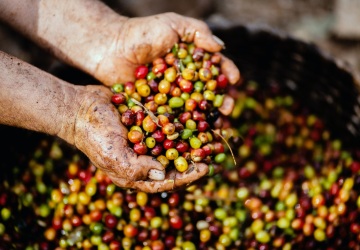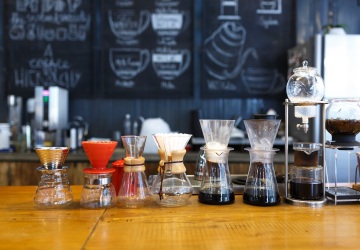With its refreshing aroma and comforting warmth, coffee is the perfect companion to start your morning. The journey from humble coffee beans to that rich, flavorful cup is fascinating. Now, it isn't as easy as it may seem, but what's a small challenge to coffee lovers for the best taste? Here are some essential techniques to achieve that perfect roast in the comfort of your kitchen.
This article is for you if you want a rich roast. This guide unveils a collection of authentic and effective methods, ensuring a delightful and natural coffee experience. To discover the freshly brewed texture and the rich aroma of the coffee, the art of hand-picking the finest beans for the roasting process is the hack.
The Stages Unveiled of Coffee Roasting
Drying Stage: Green coffee beans lose moisture as the temperature rises, preparing them for subsequent steps.
Browning Stage: Begins around 321 ℉, resulting in a toasty aroma and light brown color through chemical changes.
First Crack: Occurs at approximately 384 ℉, a crucial moment that determines flavor profile. Stopping here produces a light roast.
Medium to Medium-Dark Roasts: 411 and 461 ℉ is the perfect range for yielding darker beans ready for the 2nd crack.
Second Crack: At around 441 ℉, beans enter the second crack, causing oils to move out—dark roast with a shiny, oily surface and distinct flavor profile.
Become the Next Coffee Guru with This Guide!
Do you want to know the top secrets to achieve the perfect, rich, home-roasted coffee? You can learn the expert techniques with our well-crafted guide and enjoy the delicacy of freshly roasted beans.
Green Beans Selection
Consider the harvest date, place of origin, microregion, and optimum roasting techniques when going for this step. This is a hack that determines the flavor and quality of your coffee.
To get an incredible cup of coffee, you must keep things in check, such as preserving freshness and sourcing green beans.

Go For the Best Roast Method
The highly biased choice for the best roasting method is the skillet and oven roasting method, as it is pretty easy and can be done at home without any difficulty.
Popcorn machines are also known to roast coffee efficiently at home, which is cost-effective. Choose the method that suits your preferences and equipment availability, ensuring you can embark on your coffee roasting adventure.
Create Your Space
Adequate ventilation is essential for roast quality and safety. Ensure good airflow by using an extractor fan, opening windows, or roasting outside or in an open garage. Ultimately, this will help clear up any smoke in the air, which can harm your health.

Start Roasting
Roasting your coffee involves following the profiles outlined in your home roaster's manual or using pre-set options for guidance. The process is even more straightforward for popcorn machines, with caution against overfilling and ensuring chaff can escape.
You can choose air and popcorn machines or drum roasters according to your preferred method. They usually take 10-15 and 16-21 minutes, respectively.
Cool and Store
Remove any trash or the dried husk of the coffee bean using a small sieve at room temperature, and store the beans in a sealed, foiled-lined bag or an airtight container in an excellent place to preserve freshness. You can turn off the heat to reduce the chances of over-roasting.
This helps the coffee degas, preserving the taste, but it should be brewed before the fifth and at least after the 3rd day.
Avoiding Common Home Roasting Errors
Inconsistent Heat Application: One of the most common mistakes in home coffee roasting is inconsistent heat application. Ensure even heat distribution throughout the roasting process by using a quality roasting machine or stirring the beans continuously if using a stovetop method.
Neglecting Proper Bean Storage: Improper bean storage can lead to flavor degradation. You can follow the typical instructions for their freshness, like storing them in a cool, dry place, away from light, etc. You can find these instructions in most edible products.
Insufficient Bean Cooling: After the roasting process, it is crucial to cool the beans quickly to stop the roasting and prevent overdevelopment. Neglecting proper bean cooling can result in uneven or burnt flavors. Transfer the roasted beans to a cooling tray and gently agitate or blow air over them to speed up the cooling process.
Ignoring Resting Period: Allowing the roasted beans to rest before brewing is essential for flavor development. During the resting period, typically 12 to 24 hours, the beans release gases produced during roasting, resulting in a smoother and more balanced cup of coffee.
Overlooked Bean Degassing: Give Freshly roasted beans some to release CO2; otherwise, you will have uneven flavors if you immediately grind.
Inadequate Roast Monitoring: Roasting coffee requires careful monitoring to achieve desired results. Neglecting to monitor the roasting temperature and time can lead to under or over-roasted beans. Utilize a reliable thermometer or roasting machine with temperature control, and keep a close eye on the color, aroma, and crackling sounds during the roasting process to ensure a well-roasted batch.
Lack of Experimentation: Home roasting offers a beautiful opportunity to explore different flavor profiles and techniques. Avoid sticking to a single method or roast level and embrace experimentation.
Rushing the Roasting Process: Patience is vital in coffee roasting. Running the process using high heat or shortening the roasting time can result in uneven flavors and incomplete development.
Inadequate Bean Quantity: Pay attention to the quantity of beans being roasted. Roasting a large batch may result in uneven heat distribution and improper roasting. Find the right balance based on your roasting equipment's capacity to ensure consistent results.
Neglecting Safety Precautions: Home coffee roasting involves high temperatures and can pose risks if proper safety precautions are not taken. Use heat-resistant gloves, keep a fire extinguisher nearby, and ensure adequate ventilation to avoid smoke buildup.
Final Thoughts
By following the best techniques outlined in this guide, from sourcing high-quality green beans to proper roasting, cooling, and storage, you can achieve the elite level of your home-roasted coffee. Don't be deterred by so many steps and instructions; you can watch a YouTube tutorial if you are overwhelmed. Moreover, you can do it without making it a daunting task by following the steps mentioned in this piece.